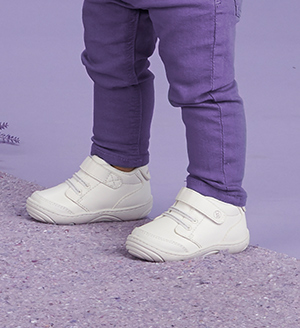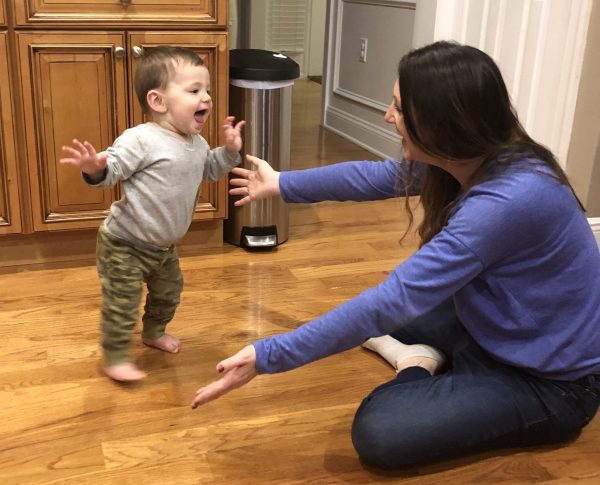How to Help a Baby Learn to Walk
It's been so much fun watching your baby larn and grow this by year. Y'all've already seen them go from babbling and starting to sit down up on their own to crawling all over the house and getting into anything and everything. If your infant is getting close to 1, yous're probably waiting for them to start walking and prepare for all the heady adventures that information technology will bring.
The good news is thatthese physical milestones mostly progress naturally with niggling aid from you. However, if y'all want to get your infant started early or worried virtually your kid not reaching this milestone already, there are a diverseness of tips I will share about how to teach your baby to walk.
PROGRESSION OF GROSS MOTOR SKILLS
Agross motor skill is an action that requires the use of larger musculus groups in your body, such equally muscles of the arm, legs, and torso. This differs fromfine motor skillswhich use tiny muscles, like the ones in your hands or fingers.
Gross motor skills in babies and toddlers include rolling, sitting up, itch, continuing, walking, running, throwing, jumping, and more. They all employ the muscles in their abdominals, thighs, and shoulders to produce these movements.
Yous'll encounter your child go through each developmental phase as those muscles become bigger and stronger. Baby'due south muscles develop and strengthen through each movement and activeness in order to gear up them for the next one.
Therefore, the trunk and cervix muscles that are strengthened through rolling and tummy time help your baby begin to sit up. The abdominal and hip muscles that strengthen from sitting, get your baby crawling. The leg muscles that your baby uses to stand upright, gear up them for walking.
And then earlier you worry most teaching your kid to walk,brand sure that they have already started crawling and standing beginning. Read here about why crawling is SO important for a babe.
WHEN SHOULD YOUR Baby START WALKING?
The typical age for a child to start walking is from ten-xv months.It'southward such a wide range consideringall children develop at their own pace. However, it's still non abnormal if your child starts walking on the end ranges or outside of this range.
Some children will have off running before you've even had a take a chance to accept that they're almost a toddler. Those are typically the fearless and outgoing children. Others may hold back on walking because they're a little more cautious or shy. You'll notice that a lot ofemerging skills tin be personality-based, rather than concrete or cognitively-based.
This means that,if your child reaches a milestone later than expected, it doesn't necessarily mean in that location is a trouble with their body or encephalon. They just may be the kind ofkid who likes to take their time(which you may be grateful for in the long run) or can't look to go there fast.
Effort not to worry about comparing your infant to others and simply focus on the capabilities of your kid. It should non matter that your niece started walking at ten months and your babe is 13 months and still non standing independently.
My firstborn starting cruising (walking along article of furniture) around nine months and took her kickoff independent steps correct before her first birthday. My son is now 13 months former and is barely taking a couple steps. Nonetheless, I'm not worried because he is right where he should be developmentally. He's hit each milestone in the right progression and is on the right foot to walking any twenty-four hour period now.
A young child volition get there when they're set up.
It's not ever a sign of something wrong if they reach a milestone late. However, be sure to consult your pediatrician if they are not walking and they are older than 15 months.
This post may contain affiliate links which I would receive a small commission should you brand a purchase.
14 TIPS TO GET YOUR Baby OR TODDLER WALKING
For well-nigh children, walking volition come up naturally as they larn the strengths and limitations of their bodies. They'll use trial and error to figure out what they can and tin can't exercise. Still, some may need a little bit more coaching to get there. Whether it be fright, conviction, or lack of practice, y'all can help your kid get in that location sooner with these tips below.
Also check out 7 Activities to Practise With Your Toddler To Make Walking FUN!
1. Be SURE THEY HAVE MET ALL PREVIOUS MILESTONES
Make certain that your kid is at adevelopmentally advisable historic period and level for them to walk. Don't button them to practise it too early or before they're ready.
Your kid should already exist able to crawl, stand while belongings on, stand up independently, and cruise (walk while belongings on) before y'all await them to walk independently. Of grade, crawling doesn't have that much to practice with walking, as some children do walk instead of crawling. However, crawling is a very important milestone that I recommend every child practice before walking.
If they accept hitting all of those stages, then you lot can start teaching your babe to walk. If not, offset working on standing and cruising before taking contained steps.
two. Become BAREFOOT

No socks. No shoes. Only bare feet. There are tiny muscles in the feet that need to start developing and strengthening and the only way to do this is by bearing weight on them.
As bipeds (animals that walk on two feet), we accept so many petty muscles that help us to residual and give traction as nosotros stand. When you lot stand barefoot, the muscles in your feet have an easier time 'grasping' the ground.This volition help those niggling muscles work harder to find the perfect style to mold to the basis in order to help your baby walk.
Not only does going barefoot help with walking, but it'southward agreat sensory experience for your child, too. All the nerve endings in the lesser of their feet will get to experience different surfaces and textures. These sensory signals become sent upwardly to the brain and provide more awareness to the anxiety. This tin can even help with walking, besides.
Barefoot waysno socks, as well. Socks will just crusade them to sideslip and don't provide plenty traction for new walkers.
3. STURDY SHOES

Get rid of those baby crib shoes with soft soles. Those aren't going to piece of work anymore.
Your baby needs ashoe with expert back up at the ankleand the sole. Recall, your baby has not withal used the muscles of their ankle and lower legs besides much yet so you may need to provide external back up to get those muscles working.
Although barefoot is the best, when you lot're out and about, your kid volition need shoes. Also, since every kid is different, your baby may not practise well with bare anxiety and may stand better with sturdy shoes.
They can keep their ankles from rolling or wobbling or only to make them experience sturdier.
Stride Rite is ane of the best shoe brands for your little ones that provide great support for an early on walker, both on the sole and ankle. *You can get them at a discounted price on Amazon.*
4. BABY STEPS
Start small and don't expect that your child volition jet beyond the living room when they first learn to walk. They willslowly begin to take 1 or two steps at a time.While you are pedagogy them, remain very close. If they can but take 2 steps right at present, don't sit three anxiety away from them. Gradually increment the distance equally they become more than confident.
5. ENCOURAGEMENT AND MOTIVATION

Be sure to celebrate every endeavor and that will encourage your child to practice more than! Nosotros all need a niggling motivation in lodge to exercise things so celebrate every little victory, whether it is ii steps or even just an endeavor to take a pace.
Thebiggest motivation for a child is a parent'due south grinning confront. Make certain you're actively engaging with your child and should start to see their abilities strengthen.
6. REDUCE THEIR Fear
Keep objects and article of furniture shut so they know that they e'er take something sturdy to agree on to.Over again, make sure you're always standing close enough to them with your arms open wide ready to catch them if they fall. In one case they realize that they won't get hurt if they fall, their fear should be reduced and they may be more than confident to take a few more than steps.
vii. GRADUALLY REDUCE SUPPORT
You can hold your infant nether their arms, on their trunk, or on their hands. As they learn and gain muscle force, they will need less and less support. Make sure you aredecreasing the amount of support and help that y'all requite them as they learn to walk.
viii. PROVIDE Adept Office MODELS
What'south more than encouraging to a child than seeing another child do it? Watching another child their age endeavour out walking will often give your babe the push button they demand to get started. They may like to see them fall and get up again or see that the other child got a lot of praise for walking.
This is where a daycare or childcare facility is helpful, however if yous have other siblings, cousins, or friends, make sure to have plenty of playdates for them to engage with others.
9. STRENGTHEN THEIR MUSCLES
As I mentioned before, your child needs to develop and strengthen their leg and body muscles in order to start walking. Make sure that you lot're giving them exposure to do so.
The best way for your babe todevelop the muscles of their legs is by standing.If your child can't hold themselves up yet, you tin can support them nether their arms. As long as they arebegetting weight into their feet with their legs straight,they are working out those muscles.
ten. Do AND CONSISTENCY
This is always my biggest tip for learning any new skill. Practice makes perfect!! Don't think that by attempting to walk with your child once a day, they will begin walking on their own. Prepare aside several periods of time throughout the twenty-four hour period to practice with them.
Whether it be in the morning when they first wake up, subsequently dejeuner, or right before bathroom time, aim to work on your goal several times. Be consistent with these tips and activities. The more your child gets familiar with your expectations of them and what activity is coming up, the more confident and excited they will experience.
11. E'er Identify THEM DOWN ON THEIR FEET
Afterward holding your child,identify them down in a standing position instead of sitting.You may be used to putting them down in sitting and that may be easiest for them, merely you desire to take every opportunity to go them begetting weight into their anxiety. Fifty-fifty if they plop down every bit soon as you place them downwardly, you're however letting them know that your expectation is for them to stand upward.
12. Allow THEM TO Prowl ON Piece of furniture

Your infant will first learn to walk while holding onto furniture. Make certain all the pieces are sturdy as they will exist pushing well-nigh of their weight onto it. Give them access to long lines of furniture (couches and coffee tables) to provide them with opportunities to cruise forth it.
xiii. START WITH A FIRM SURFACE
Although it can be scary to allow your wobbly, unbalanced babe to walk onhardwood floors or tile, this is thebest place for them to larn.
Once they're a little steadier on their anxiety, use those soft or uneven surfaces to challenge their residual a bit more. Once they get the hang of standing and walking a bit, using a variety of textured grounds like carpet, beds and couches (while supervised), and grass are groovy for the sensory feel, also as improving their remainder.
14. Ii ADULTS ARE BETTER THAN I
When having a child learn to take a few steps, it'due south all-time to have two adults instead of just ane. This but provides the encouragement and motivation that your child may need to get started. This fashionane adult can encourage the kid, every bit the other one gives him support at the other stop.
Enjoy having fun with your toddler and watching them develop this new skill of walking. Don't blink or you only may miss these fiddling milestones equally they pass! Also check out seven Activities to Do With Your Toddler To Make Walking FUN!


Related posts:
Source: https://www.teachinglittles.com/14-tips-to-get-your-baby-walking/
0 Response to "How to Help a Baby Learn to Walk"
Postar um comentário